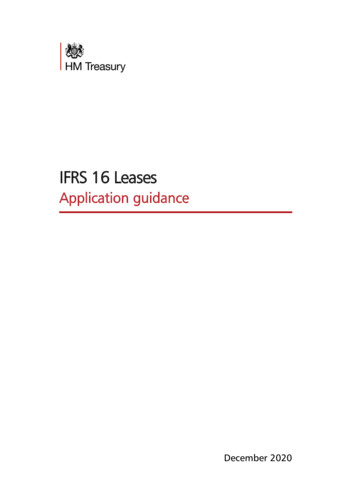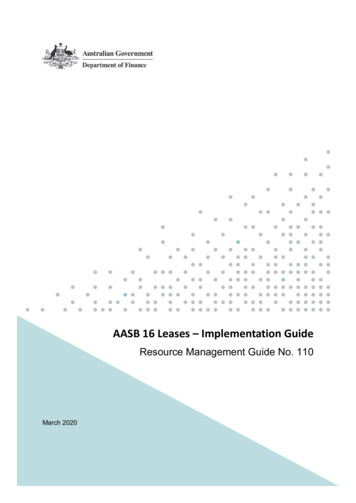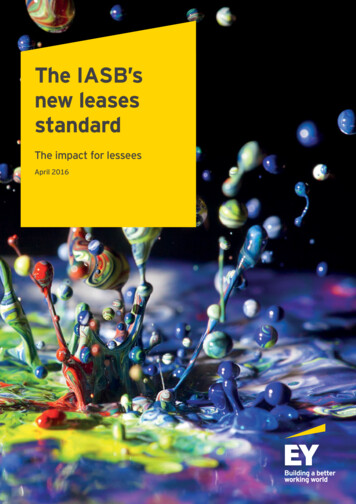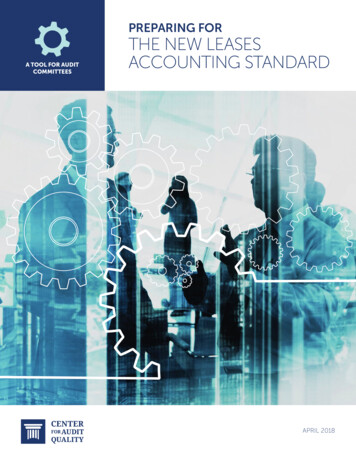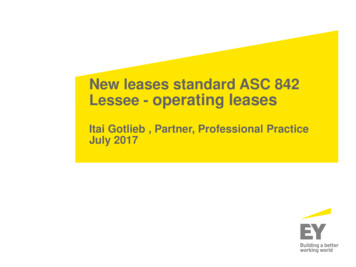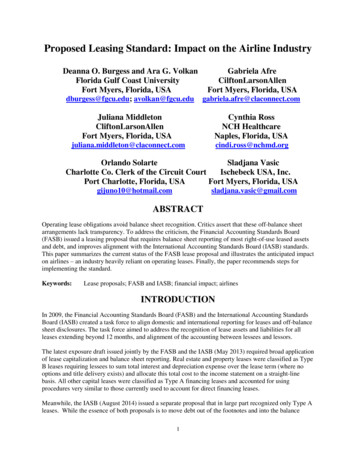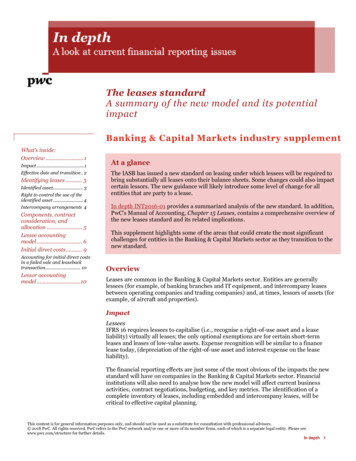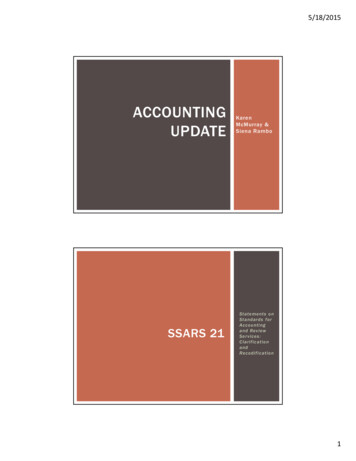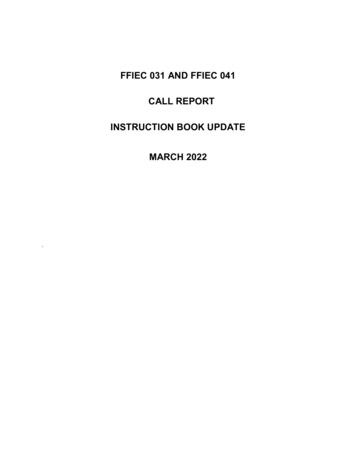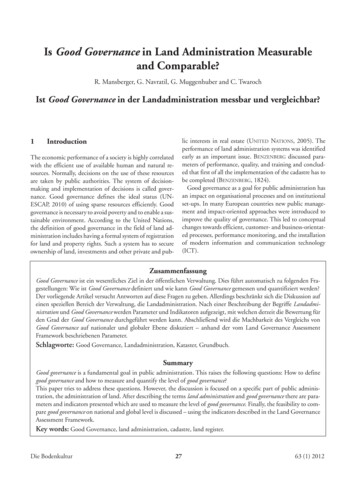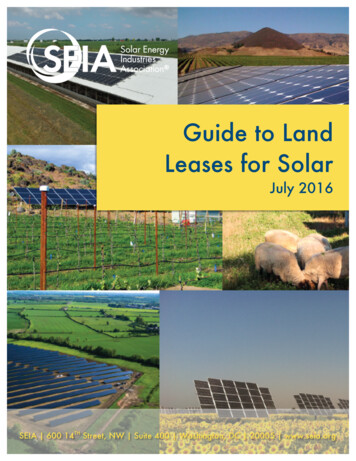
Transcription
Guide to LandLeases for SolarJuly 2016SEIA 600 14TH Street, NW Suite 400 Washington, DC 20005 www.seia.org1
IntroductionLarge scale solar projects, such as community solar and investor-owned solar systems on farms, haveexpanded rapidly throughout the U.S. These projects can use approximately 6 to 7 acres for everymegawatt (MW) of solar installed, so a 5 MW project would require 30 to 35 acres. As a result, solardevelopers (“developers”) routinely contact farmers and other landowners (“landowners”) to obtainsufficient land to develop a financeable project.Leases can provide extra income to landowners by turning unused or underused land into revenuegeneration opportunities. But entering into a lease agreement is a significant decision for any landowner.Landowners should always understand the fundamental terms of the proposed agreement, how the leasewill affect their property, and the right questions to ask developers. And landowners should always seeklegal and tax counsel before entering into any agreement with a developer.BasicsINITIAL SITE VISITFollowing an initial inquiry, a developer will visit the property to determine its suitability for a solarproject. The developer will examine the amount of available land, grading, objects shading the propertyand whether they can be removed, easements, soil conditions, and proximity to power lines, amongmany other factors.LEASE OPTIONIf a developer finds the land suitable, the developer will usually make an offer to lease the land from thelandowner. At this point, it is recommended that the landowner seek legal and tax counsel. Thedeveloper and landowner can enter into a “lease option” that provides some flexibility to the developeras he or she assembles the deal before choosing whether to exercise the option to lease the land. Underthis lease option, the landowner provides the developer time (typically 2 to 3 years) to decide if andexactly how much land he or she will ultimately lease.During this time, and until the developer exercises the lease option, the developer usually makes regularpayments to the landowner at an amount negotiated between the parties. The lease option should makeclear who is responsible for paying taxes on the land, what happens if the developer doesn’t fully buildthe project, and who is responsible for any environmental clean-up at the end of the lease. Keep in mindthat the lease option does not guarantee that the developer will lease all or any of the property.LETTER OF INTENTInstead of a lease option, some developers use a Letter of Intent (LOI). A LOI is designed to outline thelease agreement’s proposed terms and issues that need to be addressed before signing a lease. A LOIcan be either nonbinding or binding. Landowners should consult with an attorney and tax advisor aboutthe implications of entering into a LOI.LEASEOnce the developer has made the decision to begin building the intended project, the developer andlandowner, each with the advice of legal counsel, finalize the terms and enter into a binding lease. Thelease will govern the rights of the developer and landowner over the land used for the project over thelife of the project and beyond.www.seia.org2
Questions to Ask a Solar DeveloperA lease is legally binding contract and a long-term partnership and must not be entered into lightly. Thebest partnerships are those where the landowner and the developer both fully understand the deal.Asking questions upfront helps avoid misunderstandings. If a term or condition is important to you, makesure that it is included in the signed lease agreement. Below are some of the top questions thatlandowners should ask a developer before when entering into an agreement. Have you completed similar solar projects in my state? Can you provide references? Entering intoa long-term lease is a binding agreement, so do your homework. Ask for a developer’sreferences and contact them. Ask if the company is a member of the Solar Energy IndustriesAssociation (SEIA), the national trade association for solar that requires all members to abide bythe SEIA Solar Business Code, a national code of conduct. Contact the local Better BusinessBureau for the location where the developer has done business.What land will be leased? The developer and landowner should agree which part(s) of the landcan host a solar project. A developer may determine that only a portion of the land is suitablefor the project while a landowner might wish to keep that portion of land clear for their personaluse. Make sure both parties agree in writing on the portion of land for development in a mannerthe landowner finds understandable and specific.What is the effect on non-leased land? Landowners should determine the effects on the unleasedproperty. Considerations include vehicle access if the unleased portion is not along a public rightof way; the accessibility of the unleased land to utilities and other services; and current andplanned uses for the unleased property. For instance, solar developers will want to contract forprotections to ensure that trees, buildings, and other improvements do not shade the solarpanels.How long does the term run? Solar developers may propose a lease term of 20 years or morewith options to continue the lease for additional years. As discussed above, a lease can impact alandowner’s current and future use of their property, so landowners should consider their longterm plans when examining the economics of a proposed lease. The lease can even impact yourheirs and future generations.How is rent calculated? Annual rents are typically based on the amount of acreage leased by thedeveloper. Some developers may base annual rent on the amount of power (in megawatts, orMW) of the system; in this case, ask the developer the maximum and minimum feasible systemsizes to be installed. Other developers offer a base rent plus a percentage of the project’srevenues. In a percentage of revenue situation, the base rent will be lower than in a fixed-rentdeal, but the ultimate payout could be higher if the project is successful. (Keep in mind that thereis more risk associated with this structure than fixed-rent deals.) Ask whether rent paymentsincrease by a certain percentage at regular intervals.Who pays for taxes and other expenses? The lease should clearly identify whether the landowneror solar developer pays such items as real estate taxes, landowner insurance premiums andother landowner expenses associated with the property. Some issues to consider with respect totaxes are 1) whether the land leased is one or more separate tax parcels or part of a larger taxparcel, 2) whether the solar project will cause the land to qualify for any tax incentives, and 3)whether the solar project causes a loss of tax status due to conversion (e.g., if it is now used fornon-agricultural purposes).www.seia.org3
What if the land is mortgaged? If there is a mortgage or other security instrument on theproperty, the applicable loan documents should be reviewed to determine whether the leasemight trigger lender approval rights. The solar developer might also require that the landownerobtain a subordination, non-disturbance and attornment agreement so the lender agrees not todisturb the tenant’s interest under the lease in the event of a foreclosure.What protections might the solar developer’s lender want? The developer may want to finance itsimprovements, and its lender may want protections that its rights to take over the lease are notimpaired and that it has a right to cure any developer defaults. Those lender protections aregenerally not a problem because all parties wish to keep the lease in force.What happens to the developer’s improvements? The landowner will want a clear understandingof what happens at the end of the lease. Often, the landowner will want the developer to removethe solar project at such time to return the land to its original state. Such removal can beexpensive. To ensure the developer fulfills his or her obligations, a landowner may require adeposit or escrow to cover the costs of returning the land to its original state.Who will maintain the land? Issues to consider include vegetation clearance, drainage (such asstorm water management), buffer zones, fire safety, and wildlife. If the developer is responsiblefor, but fails to maintain, the land and that failure harms adjacent land or future use of theleased land, the landowner may want the right to be reimbursed for any costs or losses. Arelated concern regards liability if someone becomes injured on the land. The landowner maywant the developer to maintain insurance or indemnify the landowner for claims arising from thedeveloper’s use of the land, including environmental issues.What rights (if any) should there be to water, minerals and other natural resources? The leaseshould establish that the developer has no water, mineral or other rights to use natural resourceson the land, and that all such rights are expressly reserved to the landowner. If the developerdoes wish to contract for certain water or other rights, the parties should negotiate anappropriate compensation to the landowner.Whom should I contact if I have questions about the lease, especially following the installation?The landowner can always contact the developer to see if the two parties can figure out the issueat hand. Remember, having strong legal and tax counsel provides the landowner with the abilityto contact a knowledgeable resource.Working Out DifferencesAs with any other contract, landowners may encounter issues in dealing with a developer. In general,developers want satisfied landowners and are willing to resolve any problems that arise. SEIA and thesolar industry are strongly committed to consumer satisfaction and protection. First, try to resolve problems directly with the developer.Your contract may have a dispute resolution section and process.If you choose a SEIA solar company to work with, SEIA may be able to assist you in resolvingyour issue.If you are still having issues, note that SEIA member companies are bound by the SEIA SolarBusiness Code. If you believe a company has violated the SEIA Solar Business Code, you maysubmit a complaint to SEIA using a form available at www.seia.org/consumers.You can contact private consumer organizations (e.g., your local Better Business Bureau) aboutyour issue.www.seia.org4
In addition, state and local governments and professional associations have resources to assistlandowners. See below for more information.Additional Resources SEIA Consumer Protection Portal – www.seia.org/consumersOfficial SEIA State Chapters – ter Business Bureau (BBB) – www.bbb.orgDatabase of State Incentives for Renewable Energy (DSIRE) – www.dsireusa.orgState and Local Bar Associations - alBarAssociations.aspx#Interstate Renewable Energy Council – www.irecusa.orgNational Renewable Energy Laboratory (NREL) – www.nrel.govU.S. Department of Energy (DOE) – www.energy.govYour state or local consumer agency– www.usa.gov/directory/stateconsumer/Email SEIA with any questions at consumer@seia.orgAcknowledgmentsSEIA wishes to acknowledge the support it received from its member companies in putting together thisguide, specifically Perkins Coie, sPower, and BlueWave. SEIA also thanks Mr. Ron Lowe and Ms. BethUnderstahl from Perkins Coie for their help with drafting this guide.www.seia.org5
www.seia.orgSEIA 600 14TH6Street, NW Suite 400 Washington, DC 20005 www.seia.org
LEASE OPTION If a developer finds the land suitable, the developer will usually make an offer to lease the land from the landowner. At this point, it is recommended that the landowner seek legal and tax counsel. The developer and landowner can enter into a "lease option" that provides some flexibility to the developer

